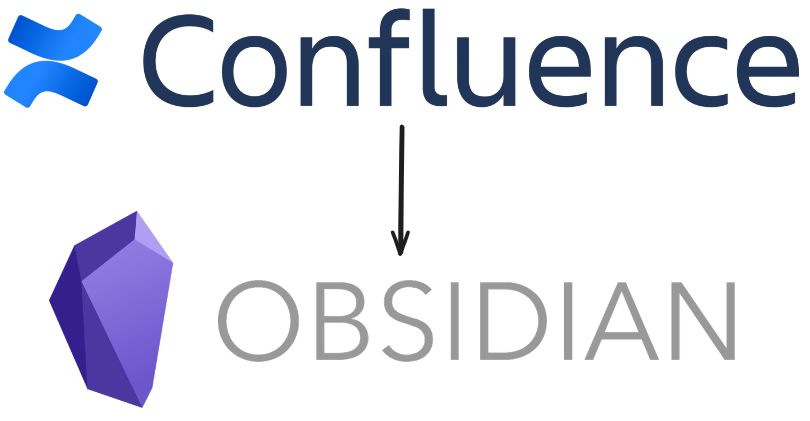
Overview
I migrated my notes from Confluence to Obsidian using a few scripts. More generically, this converts Confluence to markdown. This blog post describes the general process so others who face this problem have a starting point.
Confluence doesn’t directly support exporting a workspace to markdown. The result of my attempt was only a partial solution.
I prioritized the following:
- Preserve any text written and convert it to markdown
- Avoid excessive HTML. Try to keep everything plain markdown
The following weren’t converted to markdown:
- Folder structure
- Images
- Attachments
- Internal links between notebooks
The result was a massive folder with each page as a markdown file which could be copied and searched.
Links
How it works
- Export a Confluence workspace to HTML.
- Convert the HTML to markdown using a Pandoc in a PowerShell script.
Due to the the HTML format, not everything can get easily converted. Use a Lua filter to define how Pandoc should convert different HTML elements.
PowerShell script
# ConvetHTMLToMarkdown.ps1
# Set the path to the folder containing the HTML files
$sourceFolder = "./confluence_workspace"
# Set the path to the folder containing generated Markdown files
$destinationFolder = "./markdown"
# Set the path to the lua filter script
$luaFilterPath = "filter_html.lua"
# Get all HTML files in the folder
$htmlFiles = Get-ChildItem -Path $sourceFolder -Filter "*.html" -File
# Loop through each HTML file and convert to Markdown using Pandoc
# foreach ($htmlFile in $htmlFiles[0..10]) {
foreach ($htmlFile in $htmlFiles) {
$htmlFilePath = $htmlFile.FullName
$markdownFileName = Join-Path -Path $destinationFolder -ChildPath ([System.IO.Path]::ChangeExtension($htmlFile.Name, "md"))
$command = "pandoc '$htmlFilePath' -f html -t gfm -L '$luaFilterPath' -s -o '$markdownFileName'"
Invoke-Expression $command
}- This is in PowerShell but should be similar in bash.
- The script sets all of the parameters and file paths
- It loops through all of the HTML files and runs the Pandoc command to convert the file to markdown
- Convert a few files first to check the results before converting the entire workspace.
Pandoc
pandoc '$htmlFilePath' -f html -t gfm -L '$luaFilterPath' -s -o '$markdownFileName'- Install Pandoc. https://pandoc.org/installing.html
- The command converts from HTML to GitHub Flavored Markdown using the Lua filter.
- GitHub Flavored Markdown converted the most from Confluence HTML. It was the only format I found which could convert the Confluence HTML tables.
Lua Filter
-- filter_html.lua
function Span(el)
return el.content
end
function Div(el)
-- Removes footer
if el.identifier == "footer" then
return {}
end
-- Removes breadcrumb header
if el.identifier == "breadcrumb-section" then
return {}
end
-- Removes attachments plugin
if el.classes:includes("plugin_attachments_container") then
return {}
end
return el.content
end
function Para(el)
if el.content then
for _, item in ipairs(el.content) do
-- Out of order execution, converted links should not be stringified
if item.t == "RawInline" then
return el
end
end
return pandoc.utils.stringify(el.content)
end
end
function Image(el)
return {}
end
function Link(el)
-- if el.classes:find("download-all-link", 0) then
-- return {}
-- end
if el.classes:includes("external-link") then
link_text = pandoc.utils.stringify(el.content)
link_url = el.target
markdown_link = string.format("[%s](%s)", link_text, link_url)
return {pandoc.RawInline("gfm", markdown_link)}
end
end
-- function Table(el)
-- if el.classes:find("attachments", 0) then
-- return {}
-- end
-- end- I don’t know Lua and I didn’t really understand the Pandoc documentation. https://pandoc.org/lua-filters.html
- Only includes the contents within Span elements
- Removes the extra HTML Divs used by Confluence in the page layout
- Paragraphs are difficult to format because Confluence uses paragraph elements within lists. The filter tries to convert them to strings in order for the list to be formatted without extra indents.
- Due to out of order execution, the link conversion filter executes first. To avoid breaking the link format,
RawInlinegets ignored - This is messy and I couldn’t figure out a better way to do this. This results in inconsistent spacing for lists whenever there is a link.
- Due to out of order execution, the link conversion filter executes first. To avoid breaking the link format,
- Images were removed because I didn’t want to figure out how to fix them.
- Links are converted from HTML into the markdown format.